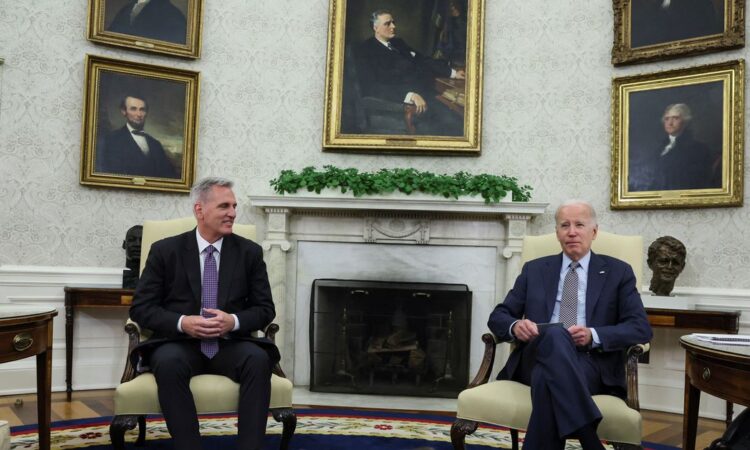
[1/3] U.S. President Joe Biden hosts debt limit talks with U.S. House Speaker Kevin McCarthy (R-CA) in the Oval Office at the White House in Washington, U.S., May 22, 2023. REUTERS/Leah Millis
WASHINGTON, May 28 (Reuters) – U.S. President Joe Biden and Republican House Speaker Kevin McCarthy on Saturday reached an agreement in principle to lift the debt ceiling that would trim some U.S. federal spending.
While the bill is still being written, the general contours of the deal have been described by sources. Sometimes, Democrats and Republicans appear not to be on the same page.
Here’s what we know so far:
A CAP ON DISCRETIONARY SPENDING
The deal would suspend the $31.4 trillion debt ceiling until January of 2025, allowing the U.S. government to pay its bills. In exchange, non-defense discretionary spending would be “roughly flat” at current year levels in 2024, “when factoring in agreed upon appropriations adjustments,” a source familiar with negotiations said. It would increase by only 1% in 2025.
Republicans have told their members that non-defense discretionary spending would be cut to 2022 levels, apart from veterans’ healthcare, which would remain fully funded.
The U.S. government will spend $936 billion on non-defense discretionary spending in 2023.
A BREATHER FOR THE 2024 ELECTION
The debt limit extension lasts past 2024, meaning Congress would not need to address the deeply polarizing issue again until after the November 2024 presidential election.
This would prevent another political showdown that rattles global investors and markets until either a Republican is elected president or Biden wins a second term.
INCREASED DEFENSE SPENDING
The deal is expected to boost defense spending to around $885 billion, in line with Biden’s 2024 budget spending proposal, an 11% increase from the $800 billion allocated in the current budget.
MOVING SPECIAL IRS FUNDING
Biden and Democrats secured $80 billion in new funding for a decade to help the Internal Revenue Service enforce the tax code for wealthy Americans in last year’s Inflation Reduction Act, a move the administration said would yield $200 billion in additional revenue over the next 10 years.
Republicans and Democrats had battled over moving that funding, which was allocated under the act as “mandatory spending” to keep it from the political fighting of the annual budgeting process, to “discretionary spending” to be allocated by Congress.
Republicans told their members that the deal canceled the 2023 funding request for new staff.
The IRS has earmarked the $80 billion for hiring thousands of new agents, and the extra tax revenue they generated was expected to offset a slew of climate-friendly tax credits. A recent IRS spending plan earmarked $372 million for enforcement in FY23 to hire 1,543 people and spent $1.4 billion in FY24 for 5,696 staff.
COVID CLAWBACK, CDC CUTS
Biden and McCarthy are expected to agree to claw back unused COVID relief funds as part of the budget deal, including funding that had been set aside for vaccine research and disaster relief. The estimated amount of unused funds is between $50 billion and $70 billion.
The bill will also cut $400 million from the Centers for Disease Control’s Global Health Fund “that sends taxpayer money to China,” Republicans told members.
WORK REQUIREMENTS
Biden and McCarthy battled fiercely over imposing stricter work requirements on low-income Americans for being eligible for food and healthcare programs.
No changes were made to Medicaid in the deal, but the agreement would impose new work requirements on low-income people who receive food assistance under the program known as SNAP up to age 54, instead of up to age 50.
STUDENT LOANS
Republicans said they ensured borrowers would have to repay their student loans. However, other sources say the deal codifies relief from student loan payments while Biden’s executive action providing up to $20,000 of debt relief per borrower is under review by the Supreme Court.
‘PAY-GO’ AND APPROPRIATIONS
Republicans said they secured a budgeting mechanism known as “PAYGO,” which is short for pay-as-you-go, that says new legislation or executive orders affecting revenues and spending on Medicare, Social Security and other key programs must be budget-neutral.
They also said that until all 12 appropriations bills were passed, a continuing resolution would cap funding at 99% of the budget allocated.
ENERGY PERMITTING
Biden and McCarthy agreed to new rules to make it easier for energy projects – including fossil-fuel based ones – to gain permit approval. McCarthy and his Republicans had identified permitting reform as one of the pillars of any deal and the White House threw its support behind the plan earlier this month.
Reporting by Jarrett Renshaw and Steve Holland; Additional reporting by Trevor Hunnicutt; Editing by Heather Timmons, Christopher Cushing and Deepa Babington
Our Standards: The Thomson Reuters Trust Principles.






